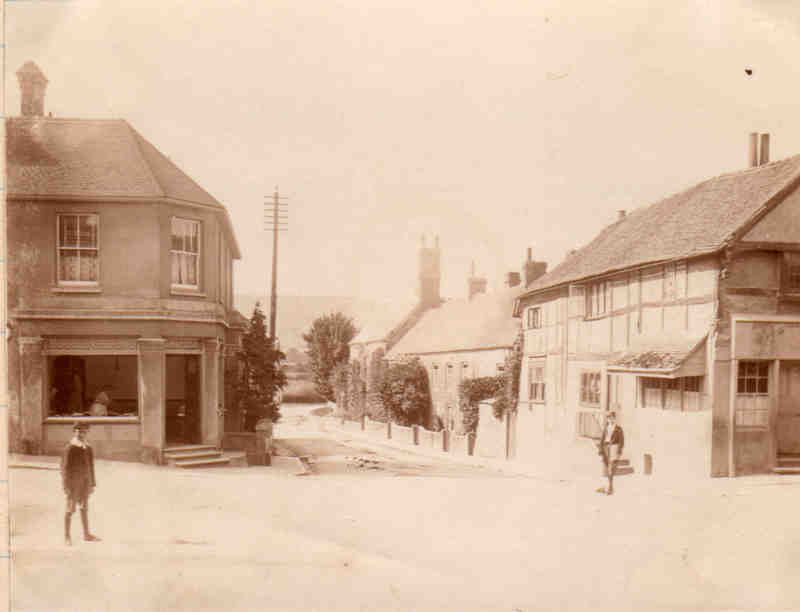THEN AND NOW ... the workhouse
From rags to riches - how the site of the Ditchling workhouse became a butcher's shop and more latterly a Goldsmith's and Jewellers.
An article by Tom Dufty first published in the Ditchling Parish Council Magazine, November 2018

THEN ...
Click on this text to start editing, and enter your own text with some basic formatting. To create a link to another page or website within this section, select the text you want to make into a link and click on the Link icon on the formatting toolbar. Click anywhere outside the text box when you're done to continue working on the rest of your page.
Christmas is coming and maybe you're thinking of buying a present for a loved one from the goldsmiths and jewellers on the crossroads. But if you were living on this site a hundred and fifty years ago you wouldn't have felt much Christmas cheer because this was the site of the workhouse. By 1776 a parliamentary report listed a workhouse here with accommodation for twenty residents and in 1835 it became one of three workhouses serving a number of parishes under the aegis of the newly-formed Chailey Poor Law Union. The population falling within the scope of the Union then was 6,977 with an average annual poor-rate expenditure of £9,576 or £1.7s.5d per head. The Ditchling workhouse was designated specifically for 'the aged'.
Agriculture provided the principal employment in the area. In the summer there was full employment but in the winter up to 25 agricultural labourers could be out of work. The daily wage in 1834 in summer was 2s 6p and in winter, for the lucky ones who found work, 2s. Women would be even luckier to find year-round work. A continuously employed labourer's family might earn a maximum annual income of £37. 12s. Workhouse occupancy and dependency on the Poor Law varied with the seasons.
The census of 1871 records eighteen males and four females living here with others supported in the community. The Overseer of the Poor provided three shillings per week, per occupant, for food and provisions which supposedly paid for a diet of meat five days a week; suet pudding on Saturdays; and Broth on Mondays!
In 1873 the three workhouses were closed and replaced by a single workhouse in East Chiltington. Not before time, because in 1871 a complaint was made about the Ditchling workhouse's 'excessively dirty state'. Not surprising then that some residents subsequently remembered it 'for the expressive grumbling of the inmates'.
Most of the building was subsequently demolished and the materials disposed of so the road could be widened. But the door to the workhouse was preserved and relocated. Today it is the front door of 'Tudor Close' the terraced cottage a hundred yards away
NOW ...
Click on this text to start editing, and enter your own text with some basic formatting. To create a link to another page or website within this section, select the text you want to make into a link and click on the Link icon on the formatting toolbar. Click anywhere outside the text box when you're done to continue working on the rest of your page.
Mr Lindfield the butcher paid £163. 9s. 2d for the old building and site, replaced it with a new building and opened Lindfield's, a butcher's shop with flats above. This accounts for the attractive pierced widow frames which provided the ventilation the shop needed. Behind it, in South St, was the abattoir. In 1937 it became the offices of the Ditchling Press after Hilary Pepler left the Guild and moved his re-named press into the centre of the village. Then, briefly, it became a high-class restaurant. Today it is the gallery and workshop of Pruden & Smith, Goldsmiths & Jewellers, co-owned, with Rebecca Smith, by Anton Pruden grandson of Dunstan Pruden (1906 - 1974) the renowned silversmith of the former Guild of St Joseph & St Dominic. Dunstan joined the Guild in 1934 and taught at Brighton College of Art for thirty years. His work was characterised by truthfulness to his materials, a high quality of finish and a meticulous attention to detail. The workshop follows in this tradition producing high quality, hand crafted 'bespoke unusual jewellery' and other ware. The basement workshop, which was part of the original workhouse, has recently been extended and re-equipped.